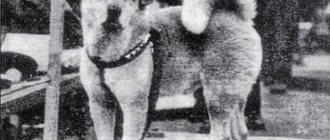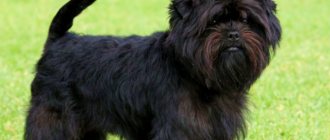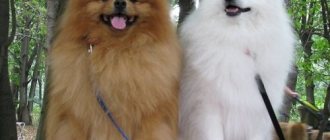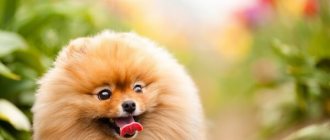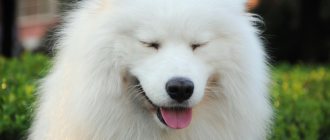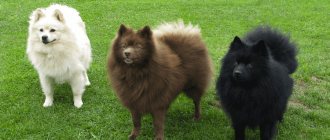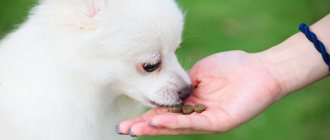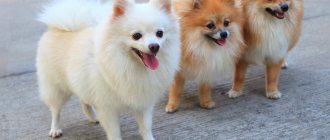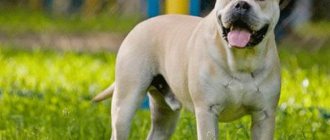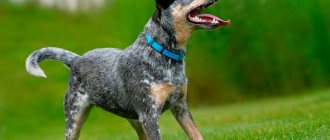Origin story
The Karelian-Finnish Spitz began its long history from ancient dogs, presumably Laikas, who lived on the lands of the Finno-Ugric peoples many centuries or even millennia ago. In the old days, they were used as hunters, watchmen and household helpers.
Finnish Spitz
A traveler from France who visited Finland in the mid-17th century discovered this breed to the whole world.
You might like this! Samoyed Spitz: description, breed standard, character and training of the dog, price of puppies, photos
At the beginning of the 19th century, the dog population practically disappeared, and only by the end of the century did dog handlers restore it by developing and approving a standard. Since then, the Finnish Spitz has spread throughout the land and to this day remains the main pride of the Scandinavians and Finns.
Story
Individuals of the breed were first noted by a traveler from France when he was in Finland. In his notes, he noted that he saw a magnificent dark red dog, which amazed him with its disposition and skills as a hunter.
After 2 centuries, a collection appeared in our country, which was dedicated to likes. And it contained a photograph of this, still unknown to anyone, but truly beautiful breed.
Representatives of the breed are also called Finnish or pointy-eared Spitz. This small dog is incredibly beautiful and graceful. It was precisely for its magnificent appearance that a large number of monarchs of that time fell in love with the dog.
A little later, in the 19th century, the Finns became interested in the breed. They began to breed this breed. A special contribution was made by two hunters who devoted their lives to the study and breeding of individuals of this breed.
The ancestors of modern dogs are considered to be Finnish bird huskies. It is worth noting that the qualities of the breed are quite similar, but long-term selection has nevertheless significantly changed modern pointed-eared Spitz dogs. It is large in size.
It is also believed that the material for representatives of the breed is commercial huskies. The name of these dogs was first registered as a temporary standard in the 1920s. After some time, individuals of the breed were under threat of complete extinction. But due to the fact that the remaining representatives from the territories occupied during the Second World War were taken to Finland, the breed was not only preserved, but also spread.
These dogs were finally established as an independent breed only in the 1960s. Today, the Karelo Finnish Laika, the breed description of which includes many positive qualities of the dog, is characterized by an original bright appearance and the presence of hunting instincts.
Description of breed standards and characteristics
Young representatives of the breed resemble a fox, but with age they lose this similarity, leaving only the color.
- Head: large, gradually expanding towards the ears.
- Muzzle: narrow with powerful jaws.
- Teeth: A healthy dog is white with prominent fangs. Strong bite, scissor-shaped.
- Eyes: almond-shaped, brown or dark brown iris, medium size.
- Ears: small in size, pointed, set high, shaped like a triangle.
- Neck: massive, medium length, well developed muscles.
- Body: no tendency to be overweight, shaped like a square, close to a rectangle with a massive chest. Straight back, medium croup, tucked belly.
- Tail: ring-shaped and of medium length, turned towards the back.
- Paws: smooth and strong, parallel, muscular.
- Coat: dense and long, rather hard, soft undercoat. Males have a furry mane on their neck.
- Color: soft red, red, red-brownish. Specimens that are brighter in color are valued.
- Size: medium.
- Weight: 10-13 kg.
- Height: 42-47 cm.
Breed standard
The life expectancy of the Karelian-Finnish Laika, unlike other subspecies, is from 10 to 14 years.
Puppies for hunters of domestic and foreign blood Karelian-Finnish Laika
2021/07/28 | Qty | Discuss in the forum: | Print:
Puppies are examined by the club's dog handlers within 45 days with the issuance of documents on the origin of the RKF, a veterinary passport, with affixing a brand and a chip, and possibly receiving hunting documents! You can leave a request for a puppy by phone. 89852260227/89775640857 (whatsapp) or online
. DELIVERY to any region and anywhere in the world! Delivery is available every day! Delivery abroad in accordance with your travel schedule!
english version
Karelian-Finnish Laika/Finnish Spitz puppies in the Moscow region
born 11/30/2020, information about the litter,
2 males
and
1 female
. The litter was registered on January 17, 2021.
Club Suomen Maximilian RKF5660579 (Champion of Russia, Champion of RKF) X Ursulina RKF4665465 (Junior Champion of Russia).
ADULT PUPPIES AND ADULT DOGS:
All information by phone 89852260227
Dear future owners of Karelian-Finnish Laikas! It is no secret that 50% of fans of the Karelian-Finnish Laika/Finnish Spitz breed are not hunters. We kindly ask those who want to find only a companion in a dog, do not buy puppies from litters recommended for hunting!
Source:
News archive
Photo
In the photo you can see what representatives of the Karelian-Finnish Laika look like:
Red Finnish Spitz
On a walk
Family
Raising the Karelian-Finnish Laika
It is difficult to train a Finnish Spitz, but it is extremely necessary. It is better to direct active energy and a lively mind in the right direction. Training lessons are kept short (25 minutes each) in the form of a game so that the dog does not lose interest. If the dog gets tired, he will become disobedient. Tasty rewards during training are a must. The Karelian-Finnish Laika breed is distinguished by its intelligence, which is why in half the cases these dogs repeat the task the first time. Training is needed daily.
It is very important to toilet train puppies. At first, it’s easy to tell by the dog’s spinning and looking for a place that he needs to recover. Then the puppy is placed in a pre-prepared place or taken outside. If you are not taught to defecate in the yard or in a special toilet, then the Karelian can dirty your house or apartment. To prevent the Finnish Spitz from learning to sleep in an apartment on the owners’ bed and from climbing onto sofas and armchairs, you need to cover prohibited areas with newspapers.
Character and behavior of the Lapphund
The Lapland Spitz is a strong and resilient dog, endowed with a high level of intelligence. In the circle of his owners he is very affectionate and flexible, he behaves like a toy. If members of the family in which he lives are in danger, he immediately gathers and actively protects the owners.
Even when in rest mode, the Finnish Spitz remains vigilant and carefully monitors its surroundings, instinctively preparing to rush to protect the owner, as well as other family members and territory. For this breed, the size and number of enemies encroaching on their domain are not important.
Relationships with other pets develop at a tolerant level only when social adaptation and proper upbringing have been carried out at an early age.
It is interesting! What dog breeds are most similar to Spitz?
A healthy dog needs long walks and regular exercise. If you do not allow the dog to lead an active lifestyle, he will find something to do at home, which can lead to damage to the property and personal belongings of the owners.
Your dog needs regular exercise
These dogs are excellent watchdogs, very vigilant and attentive to everything that happens around them.
Features of character and behavior
This is a lively and active dog with a determined demeanor. May be wary of strangers.
Advantages
- This is a socially oriented dog. She is devoted to her owner, is determined to communicate with him, and waits for approval of her actions. He treats children well, plays with pleasure, and does not show signs of aggression. She is vigilant and cautious towards strangers, but is not hostile.
- The Finnish Spitz is a very active dog with excellent working abilities . He is courageous, decisive, and capable of making independent decisions.
- A good sense of smell and stamina allow him to track or pursue prey for many hours . The dog appreciates exercise, any kind of activity, and will be happy to go on a trip to nature with its owner.
- This is a fast and quite smart dog that can successfully learn new commands . When hunting, she is passionate and emotional, but in the right situation she is able to show patience and restraint. At home, the Spitz is good-natured and friendly.
Flaws
- One of the main disadvantages of the breed is its tendency to bark and howl.
- This indicator is a plus during hunting, but in an apartment building it can cause conflict with neighbors. It is advisable to train your pet from childhood to use its voice only in the right situation. Barking at the owner should not be allowed.
- The dog requires a high load and active walking; in their absence, it is capable of destructive actions indoors. Also, when deprived of the opportunity to express energy, a Spitz can become nervous and excitable. This dog is not suitable for lying on the couch with its owner.
- Despite its attachment to its owner, the Finnish Husky can show a tendency to dominate if it feels weak. Hunting inclinations make the pet independent and decisive, so he sometimes shows stubbornness and does what he thinks is right.
- It is difficult for Spitz to get along with other animals, especially small ones. They are often perceived as being hunted. Instincts can provoke a dog to chase during a walk, so it is better to keep him on a leash.
Content
If you don’t go hunting with your dog, you need to imitate this activity in a game so that the pet doesn’t get sad. You can live with this breed in an apartment, but it is necessary to spend a long time walking.
Brush the coat twice a week at normal times, and when shedding, do this every day. Bathe your dog no more than 4 times a year as it gets dirty. Clean your ears and eyes regularly, trim your nails and the fur between the webs on your paws.
The Finnish Spitz is not picky about food and has an excellent appetite.
Important ! If the level of physical activity is insufficient, limit your pet's food intake.
The diet is quite simple:
- lean raw meat;
- cartilage;
- chicken feet, necks;
- oat and buckwheat cereals, rice;
- fruits, boiled vegetables;
- milk products.
To keep your dog healthy, feed it 2 times a day.
If you don’t have time to prepare a balanced meal for your pet, purchase luxury food. It is best to consult a veterinarian first.
Contents of the Karelian-Finnish Laika
Unpretentiousness in maintenance is the biggest advantage of the Finnish Spitz. The small size of the dog allows it to be kept in both apartments and private homes. Frequent and active walks are a necessity when keeping this dog. It is not worth putting such a dog on a chain, because he may get sick. A personal place is required: bedding and a separate enclosure or house. If a Finnish Spitz puppy will live on the street, breeders recommend keeping it in the house until the first molt, and only after that placing it in an enclosure or kennel.
Karelo-Finnish Laika – keeping in an enclosure
Although Karelians are adapted to cold weather and can withstand severe frosts, they need a warm enclosure where the dog can hide from the weather. Karelian-Finnish huskies are very attached to people, so it is worth taking care of a separate place in the house, even if they are kept outside. The Finnish Spitz is not suitable for home guarding; it can greet any noise with a loud bark. For protection in the forest, he has no equal. If possible, it is worth finding company for your pet so that the dog can behave calmly in society.
Karelo-Finnish Laika keeping in an apartment
The greatest difficulty in keeping a Karelian-Finnish Laika dog in an apartment is its ringing voice and active behavior. The presence of such a pet obliges the owners to take long and frequent walks. If a dog is kept indoors for a long time, it may develop depression. The recommended minimum of active walks with free range is 2-3 hours a day. While walking, you should constantly monitor your active pet. The Finnish Spitz can provoke a fight with another dog. The apartment must have toys for the dog.
Family life
Dogs need long walks every day. Maintain a balance between family companionship and outdoor exercise.
By nature, they get along well with children, so they can act as nannies.
Despite all the love and reverent attitude towards the family in which the Spitz lives, he will not show tenderness towards strangers, but will treat them with caution. This breed has a well-developed protective instinct.
They are wary of strangers
To ensure that your dog has good manners and is balanced from early childhood, train him.
History of the origin of the species
The origin of dogs of this breed remains unclear; presumably their ancestors were aboriginal dogs of northern peoples (Finno-Ugric). The exact date of the appearance of the Finnish Spitz has also not been established; the first mentions are found in the descriptions of the French traveler P.M. de Lamartiniere, dated 1653 . He describes the red hunting dogs of the Scandinavian peoples, and also leaves their images in manuscripts.
At that time, Spitz dogs did not always have the same appearance, because... the different tribes rarely had contact with each other. However, the working qualities of the dogs were excellent throughout.
Dogs were used to hunt birds, which they bred under guns, small predators, such as martens, and also to drive larger animals - deer, wild boar, bear - to their owner.
In some cases, the Spitz could penetrate large burrows . One of the features of Finnish dogs was their ringing voice, with which they notified the hunter about their actions. The goal of selection was to obtain an animal with high performance characteristics, good health and not requiring special care.
After the advent of railway communication in the 19th century, residents began to actively communicate with each other. Dogs were crossed, forming mestizos with less pronounced performance indicators, which practically led to the degeneration of the breed . In 1880, the enthusiast and hunter H. Roos began rescuing Finnish Spitz and targeted selection.
In the 90s 19th century The first stud books of the breed appeared, and in 1892 a standard was developed. Dogs began participating in exhibitions 5 years later. In the 20th century dogs have gained popularity in Europe and the USA. In 1979, the Finnish Spitz was recognized as the national breed of its country. To date, these are predominantly hunting dogs with pronounced instinct.
Education and training
Thanks to its intelligence, the Finnish Spitz is an excellent learner. Start training in a timely manner and you will be able to raise an obedient, devoted friend. Do not forget to adhere to a systematic approach during the educational process and take into account character traits.
Education is simply necessary for this breed, because it tends to dominate. A Spitz should already understand from a young age what he can and cannot do.
Information on topic! Types of Spitz and their character.
Due to extreme attentiveness to what is happening around, the pet may be distracted from the boring training process. Therefore, if you cannot get your dog interested in this activity, contact a dog trainer for help. This will allow the animal to socially adapt in a timely manner and instill good manners in it.
Training
When training a Finnish Spitz:
- use incentive techniques;
- do not get bored by repeating tasks too often;
- build exercises in a playful way;
- do not use physical punishment.
Like again!
The Karelo-Finnish Laika was included in the State Register of Breeding Achievements of the Russian Federation in 1993. Photo: MTRK "Mir"
The real Karelian-Finnish Laika breed needs to be preserved - this is the opinion of the majority of Russian dog handlers. And it was heard. The end to the long-term dispute was put at the beginning of 2021 during a meeting of the Russian Canine Federation. The Karelian Laika is officially recognized as a separate breed of dog.
This is a great achievement for Karelian cynologists, who have long fought for the special status of the breed. They are especially pleased that, thanks to its name, the dog will become a unique symbol of the Russian region.
Puberty and mating
The female is ready for mating already at her first heat, but it’s better not to do it. Allow the body to adjust the cycle and fully develop. Suitable days for mating are from 11 to 15 days from the start of estrus.
It is better to breed females and males by the age of two. Early sexual activity will harm the health of the pet and the puppies.
Before mating, give the dog a good walk, but do not feed it. Introduce your pets on neutral territory. After walking together, take the dogs to the dog's territory. Don't interfere with the process.
If there are differences in height and the male is smaller, place a pillow under the hind legs; if the female is smaller, then place her tummy on the bent knee.
Important ! Never bend the bitch's paws to help the dog.
To be sure of the result, be sure to repeat the mating after 24-48 hours.
Care and maintenance
The Karelo-Finnish Laika does not require special care. The coat needs to be combed. The cleanliness of the ears and the absence of inflammation should be checked weekly, and if necessary, cleaned with a cotton swab. The claws wear down on their own due to active walking, but it is advisable to check their condition once a month and, if necessary, trim them. Eyes and teeth are cleaned weekly.
Nutrition
Representatives of the breed love to eat, but if there is enough exercise, they do not gain excess weight. With little activity, you should carefully monitor the diet and portion size, and do not overfeed your pet. Food can be prepared professionally or natural. In the latter case, it is worth giving additional vitamins and minerals.
The natural feeding method involves the use of the following products:
- Lean meat, offal;
- Bouillon;
- Porridge (buckwheat, rice, etc.);
- Vegetables (carrots, zucchini, potatoes);
- Unsweetened fruits;
- Eggs;
- Fermented milk products;
- Greenery;
- Fish (sea);
- Cottage cheese.
It is not recommended to give your dog bones, especially tubular ones, chocolate, spicy and smoked foods, and fatty foods.
Salt should be used in minimal quantities. Pepper and spices should not be present in the feed.
Among ready-made nutrition brands, it is worth choosing those belonging to the super-premium or holistic categories. They use natural products, lack or contain minimal amounts of dyes and flavors, and also include the required amount of vitamins.
Dogs are fed at intervals appropriate to their age. Adult Spitz dogs who are 10 months old. food is served twice a day. For puppies the following frequency is established:
- 2-4 months – 5-6 times;
- 4-6 months – 4 doses;
- 6-10 months - 3 times.
We recommend that you read a detailed article on the topic: “How and what to feed a dog: types and characteristics of nutrition.”
Health
Pets belonging to this breed are in good health. With proper care and timely vaccination, they live quite a long time.
Vaccinations
Dogs that are vaccinated develop immunity to major diseases common among dogs. Preparation for vaccination includes mandatory deworming, which is carried out a week before the event. For adult dogs, the event is held once a year .
For puppies, vaccinations must be given twice: at 8-9 weeks and at the age of 3 months . The vaccine is identical, but in the second case a rabies marker is added.
After vaccination, the puppies are quarantined for 14 days , during which the kids are not allowed to go outside. The owner needs to monitor the behavior and health of the pet during this period; if fever, vomiting, loose stools or lethargy appear, then a visit to the veterinarian is required.
Vaccinations protect against the following diseases:
- plague;
- leptospirosis;
- parainfluenza;
- coronavirus;
- hepatitis;
- parvovirus enteritis;
- trichophytosis;
- rabies.
Important article on the topic: “Everything you need to know about dog vaccinations.”
Diseases
The breed was not bred artificially, so it is distinguished by good health. Among the emerging problems are:
- Dysplasia of the hip and elbow joints . This is a congenital disease, the first manifestations of which can be noticed at the age of about 1.5 years. The dog has difficulty going down stairs and experiences pain when running or walking. If left untreated, the disease leads to immobility.
- Epilepsy. Spitz dogs may experience seizures due to a congenital brain disorder.
Walk
This is a dog that requires high exercise and active walks . She needs to run, swim, overcome obstacles. Your pet will appreciate playing ball or frisbee, hide and seek, exercise on dog equipment, and coursing.
At least once a week, the pet needs to go out into nature or freely walk in a fenced area. If there is no fence, you should not let your pet off the leash; its hunting instincts can lead it far from its owner.
Read a useful article on the topic: “Dog walking law, what you need to know about prohibitions and fines.”
Grooming
The long coat of the Finnish Spitz requires weekly brushing. During shedding, which happens twice a year , the dog's coat must be brushed daily . Bathing with shampoo is possible, but limited. 3-4 times a year is enough . In other cases, you can wipe the paws and fur with a damp cloth or rinse under running water.
Pros and cons of the breed
The advantages of Finnish Spitz include:
- independence;
- getting along with children and pets;
- good health;
- unpretentiousness in food;
- stable psyche.
The owners include the following disadvantages:
- excessive appetite;
- difficulty in learning and training;
- stubbornness The déjà vu effect is still little studied by scientists.
Why this feeling occurs cannot yet be precisely explained. If a person frequently experiences déjà vu, this may be a symptom of a developing mental illness. Déjà vu is a little-studied state of the human psyche. The phenomenon interests specialists from different fields of knowledge. However, precise information determining the mechanisms of its occurrence is lacking. This gives rise to many versions. Official psychology tends to attribute the effect of repeating reality to the onset of serious psychological illnesses. Mystics claim that this condition is associated with experiences associated with past life memories.
What is deja vu and how does it feel?
Figure 1. Still from the film “Obsession”
The term comes from the French déjà vu. The literal translation is “already seen.” I saw what was happening at that very moment. There is a strong impression of a duplicate event, as if it had already happened:
see these people;
This causes surprise and fear, but soon this feeling disappears without a trace. The gift of clairvoyance, suddenly awakening, disappears just as suddenly. Usually this moment lasts no more than a few seconds. And the person does not so much remember the event itself, but rather the feeling that accompanied it.
Usually a person has experienced déjà vu at least once. Some people experience this phenomenon often, while others experience it once or twice in their lives.
Interesting! There are several phenomena similar to the concept of déjà vu:
- Deja Senti is when a person remembers a thought that has previously occupied his imagination.
- Deja Entendu - the new information just heard seems familiar to the person.
- Jamevu is a familiar environment, things and people are perceived in a new way, striking with the novelty of perception.
- Groundhog Day is when you get the impression that the same scenes, emotions, and events are being played out all the time.
Memory error - the opinion of scientists
Figure 2. Scientists claim that déjà vu is a memory error
The state of “déjà vu” was first described by the French psychologist Emile Boirac in the book “Psychology of the Future.” The Frenchman was the first to define the term. After the publication of the book, a lot of other works appeared on this topic. The phenomenon was considered from both a scientific and mystical point of view. However, no accurate information has been added, since this phenomenon is spontaneous and individual. It is impossible to use technical instruments to analyze it.
In 2006, an attempt was made to analyze déjà vu using hypnosis. It was based on the fact that when a person recognizes events or people as familiar, something like this happens. The brain goes through the memories, and in case of coincidences, another area of the brain establishes the authenticity of the ongoing process. It turns out that déjà vu is the launch of the second part of information processing by mistake.
There were other theories:
- short-term and long-term memory fails, i.e. momentary information is directly sent to long-term memory;
- somehow the area of the cerebral cortex that controls familiar sensations is activated without the participation of memory;
- Déjà vu is a memory disorder.
Video
Documentary film of the TV channel “Russia 1” - “Deja Vu. Someone else's memory."
Dream or work of the subconscious
Sigmund Freud theorized that déjà vu is the recollection of images from our forgotten dreams. This version is supported by modern dream researchers. The fact is that a person mainly dreams of scenes related to everyday life. While we sleep, the subconscious processes possible options for the development of an event that worries us at this moment in life.
And since a person rarely remembers his dreams, when something similar happens in reality, it seems that this has already happened to us. This phenomenon is based on this effect. It turns out that deja vu is the options for the development of an event calculated in a dream by the subconscious.
Memory of past lives
Figure 3. Jung put forward the version that déjà vu is the result of genetic memory.
The lack of accurate knowledge about the mechanisms of déjà vu has given rise to various guesses and mystical versions. Among them is the hypothesis that the phenomenon is associated with previous human lives, i.e., reincarnation. The incredible version, however, aroused the curiosity of specialists from different fields of knowledge at all times.
Remarkable! This version is completely contrary to the philosophy of Christianity. Since, according to religious canons, a person comes to earth only once. His task is to live his life in such a way that he will not be afraid to appear before God during the final Judgment.
The first version that déjà vu is a residual memory of past lives was expressed by Carl Gustav Jung. To avoid the mystical term “reincarnation,” he renamed it genetic memory.
It must be said that the Swiss theory is popular among his contemporaries. Many stars share their memories from past lives. For example, Madonna claims that in a past life she was one of the many servants of the Emperor of Manchuria. It’s interesting that she learned about this after feeling déjà vu while visiting the imperial palace in Beijing.
Another interesting story was told about herself by singer Tina Turner. Turner shared with the press that in one of her earthly incarnations she was the queen of Egypt - Hatshepsut.
Is deja vu good or bad?
Usually deja vu has a neutral meaning. However, if the phenomenon occurs to a person often, then this may be a harbinger of illness. After all, Aristotle warned that déjà vu is a malfunction of the brain that leads to serious psychological illnesses.
The words of the ancient philosopher are confirmed by experts. For example, Professor Chris Moulin talked about one of the patients at the Memory Disorders Clinic in Bath. The patient was tormented by constant obsessive déjà vu. This was due to the loss of brain cells caused by dementia.
There are many cases recorded in medicine where frequent repetitions of reality were a sign of psychological illness. It is recommended that people analyze the past less:
- with a receptive nervous system;
- patients with epilepsy;
- experiencing certain psychological problems.
How to get rid
You can protect yourself from constant repetitions of reality by resorting to the following simple tips:
- avoid stress and conflicts;
- try to get enough sleep, avoid constant lack of sleep;
- periodically change the environment, routine negatively affects a person’s psychological state;
- do not use substances that alter the state of consciousness - drugs, alcohol, tranquilizers.
If these techniques do not help, then a visit to a neurologist is mandatory. Frequent déjà vu can mean the onset of serious psychological illnesses. Don't put off going to see a specialist.
In addition to their appearance, according to owners, the dogs have excellent watchdog and hunter qualities. Peaceful animals towards their family members.
Purchase: nuances, prices, nurseries
Before choosing a Finnish Spitz dog, decide for what purpose it is needed. If the dog will be used as a hunter, you can purchase a puppy with some flaws in the exterior, for example, with a lighter coat and nose than specified in the standard.
Before buying a puppy, decide for what purpose you need it.
When buying a dog for a show, check it for full compliance with the standard, paying attention to:
- coat color;
- nose;
- clarity and color of eyes;
- tail shape;
- croup shape.
In addition to appearance, pay attention to the pet’s activity, its gait and the condition of its limbs.
Prices for Finnish Spitz puppies are quite high. They depend on the following factors:
- presence of pedigree;
- exterior;
- Purposes of the acquisition.
Show dogs are more valuable.
Finnish Spitz: exhibition
Do not buy Pomeranians in transit or at poultry markets. It is better to contact a special nursery for breeding this breed. During the sale, employees will provide not only documents, but also further recommendations on care and maintenance.
Maintenance and care
Laikas are low-maintenance pets, but this does not mean that they do not need regular veterinary examinations and human care.
Some tips for caring for such a dog:
- She sheds two or three times a year, which means she needs daily brushing. For this procedure, a special soft-tooth comb designed for combing out pet hair is suitable.
- The animal's eyes should be washed weekly with tea or tea leaves to remove dust and pathogens from the surface of their mucosa.
- His ears should be cleaned of wax as they become dirty. If dirt is not removed from their surface in a timely manner, inflammation will occur.
- When the KRL grinds off on its own, but if she doesn’t do this, you will have to use a nail file and help her with this.
- You will have to bathe your pet 3-5 times a year, at least. If you do not wash his fur with shampoo, it will begin to emit an unpleasant odor.
What to feed the Karelian-Finnish Laika
As a fairly large dog, the CRL needs large amounts of carbohydrates and protein to convert into energy. By the way, by the dog’s behavior you can judge the quality of its nutrition. If he moves a lot and is in high spirits, it means he receives the necessary amount of nutrients.
We recommend feeding your purebred hunting dog with super-premium food, preferably dry. The standard dosage for an adult is 350-400 grams.
It is better to give the animal food twice a day and at the same time. This is useful, firstly, for his health, and secondly, for discipline.
There is an alternative option - give him food from your table. An adult dog should consume sufficient amounts of amino acids and minerals. Therefore, the optimal product for it is buckwheat with bone meal. If desired, you can additionally give him meat, bones and fortified foods, that is, vegetables and fruits.
How to feed a bear husky puppy
The CRL baby is very active and cheerful. Therefore, in order to maintain good physical shape, in the first year of life he should consume a lot of protein foods, such as:
- Milk.
- Cottage cheese.
- Cheese.
- Serum.
- Ryazhenka.
He needs to give them daily, preferably in small portions. As the Karelian-Finnish husky puppy grows, the amount of food should be increased.
In addition to dairy products, he should also be given vegetables, bone cartilage, soups, fruits and cereals. A baby aged from 2 to 4 months is fed about 5 times a day, and a more mature one (up to 9-10 months) - 3-4 times a day.
A one-year-old dog can be completely switched to dry food, but not abruptly, so that it has time to develop a new taste habit.
